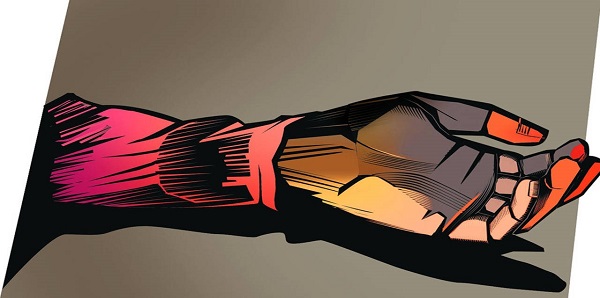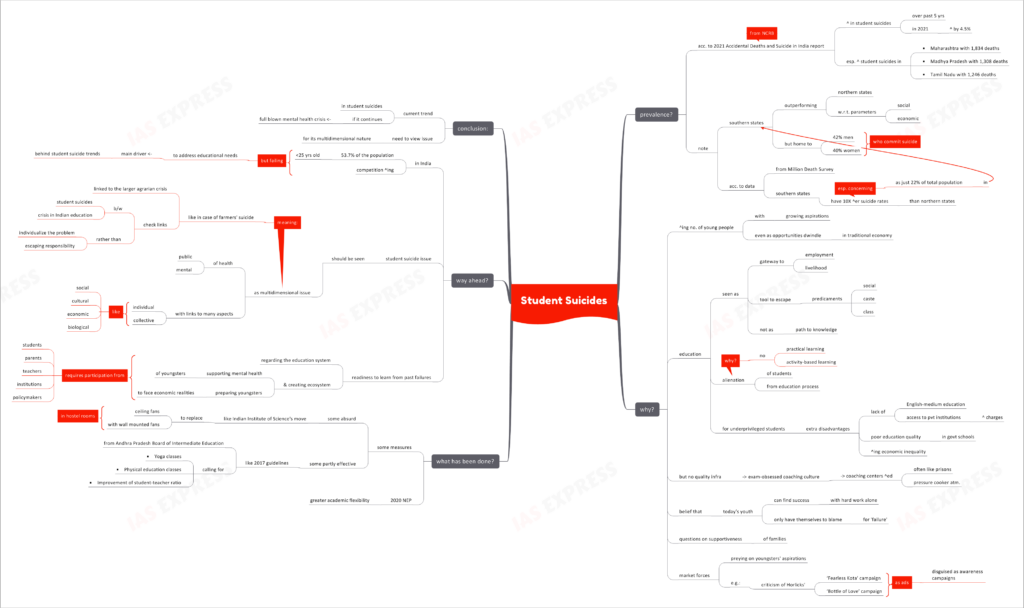Student Suicides- Trends, Drivers and Measures

In separate incidents, 3 students died by suicide in Kota district, Rajasthan. This is a signal that the 2-year interlude brought on by the pandemic is over and has again brought into focus the concerning issue of student suicides.

This topic of “Student Suicides- Trends, Drivers and Measures” is important from the perspective of the UPSC IAS Examination, which falls under General Studies Portion.
How prevalent is the issue?
- According to the 2021 Accidental Deaths and Suicide in India report of the NCRB, released in August:
- The number of suicide deaths among students have been increasing steadily over the past 5 years. It increased by 4.5% in 2021.
- The highest number of students suicides were recorded in:
- Maharashtra with 1,834 deaths
- Madhya Pradesh with 1,308 deaths
- Tamil Nadu with 1,246 deaths
- An interesting point to note is that while various reports show that southern states outperform their northern counterparts in different social and economic parameters, 42% of men and 40% of women who commit suicide hail from these southern states.
- Data from the Million Death Survey shows that southern states have 10-times higher suicide rates than the northern states. This is especially concerning given how southern states account for just 22% of the total population.
Why is this happening?
- The larger problem goes beyond Kota and its coaching centers’ pressure cooker atmosphere. India is home to a large number of young people with growing aspirations, even as the number of opportunities in the traditional economy shrink.
- In India, education is perceived more as a gateway to employment and livelihood rather than a path to knowledge. Many students and their families view it mainly as a tool to escape their social, caste and class- predicaments.
- Students are often alienated from the educational process itself i.e. they are unable to relate to it or actually apply it to their lived reality. This is due to a lack of activity-based/ practical learning.
- Students from the underprivileged sections find it even harder due to a number of disadvantages:
- Lack of English-medium education
- Poor quality of education in government schools
- Lack of access to private institutions that charge high fees
- Growing economic inequality, etc.
- The failure to develop quality educational infrastructure has bred an exam-obsessed coaching culture. Consequently, coaching centers have emerged as a predominant player in the Indian education scene.
- These centers are too often like prisons for many youngsters.
- Adding to this is the belief that today’s youth can find success if they work hard enough, irrespective of their situation, and should only have themselves to blame for their ‘failures’.
- The rising number of suicides are raising questions on how supportive the Indian family structure actually is for students.
- Market forces are preying upon the youngsters’ aspirations. For instance, Horlicks was criticized for its ‘Fearless Kota’ campaign and ‘Bottle of Love’ campaign as advertisements masquerading as awareness campaigns.
What has been done to address it?
- Over the years, a number of measures have been taken to address student suicides.
- Unfortunately, some have bordered on the absurd, for instance- Indian Institute of Science replaced ceiling fans in its hostel rooms with wall-mounted fans last year.
- Some other measures have atleast addressed a part of the problem. For instance, the Andhra Pradesh Board of Intermediate Education issued guidelines in 2017 to reduce the pressure on students. It called for:
- Yoga classes
- Physical education classes
- Improvement of student-teacher ratio
- The 2020 Education Policy envisions greater academic flexibility for the students.
What is the way ahead?
- In India, 53.7% of the population are below 25 years of age and the economy is becoming increasingly competitive. The failure to address the educational needs of this young population is a key driver behind the concerning trend in student suicides.
- Suicide should be perceived as a multidimensional public and mental health issue. There is a need to acknowledge its links to various aspects- both individual and collective- like social, economic, cultural and biological aspects.
- This means that, like how the farmers’ suicide issue was linked to the larger agrarian crisis, the issue of student suicides should be studied for its link to the crisis affecting the academia, rather than individualize the problem and thus escape societal responsibility.
- What is required is a readiness to learn from past failures regarding the education system and create an ecosystem that would support youngsters’ mental health and prepare them to face the economic realities.
- This requires participation from all the stakeholders: students, parents, teachers, educational institutions and also, policymakers.
Conclusion:
If the current concerning trend in student suicides were to continue, India would have a full-blown public mental health crisis on its hands. There is a pressing need to view the issue for its multidimensional nature, if we are to start addressing it.
Practice Question for Mains:
Comment on the issue of student suicides in India. What is driving this trend? (250 words)

